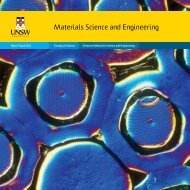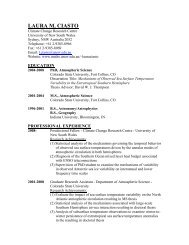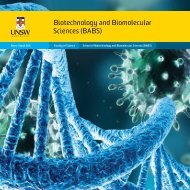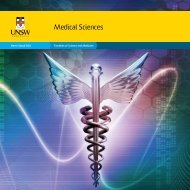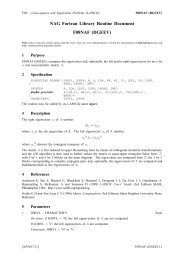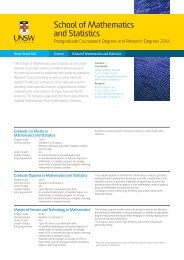2011 Postgraduate Research Competition - UNSW Science - The ...
2011 Postgraduate Research Competition - UNSW Science - The ...
2011 Postgraduate Research Competition - UNSW Science - The ...
Create successful ePaper yourself
Turn your PDF publications into a flip-book with our unique Google optimized e-Paper software.
Page |33<br />
Yeast genome-wide analysis identifies cellular<br />
processes affecting aggregation of amyloid beta<br />
42-GFP fusion reporter<br />
Suresh Nair and Ian Dawes<br />
School of Biotechnology & Biomolecular <strong>Science</strong>s<br />
Abstract<br />
Alzheimer’s disease (AD) is the leading cause of dementia in individuals over 65 years of age;<br />
and the risk of developing Alzheimer’s disease increases steadily with age. Amyloid-beta (Aβ)<br />
plaques, composed of aggregates of Aβ peptides, are a major neuropathological feature of<br />
AD. <strong>The</strong> two major isoforms of Aβ peptide are Aβ40 and Aβ42, of which the latter is highly<br />
prone to aggregation and shown to support a central role in AD disease progression. <strong>The</strong><br />
increased presence and aggregation of intracellular Aβ42 peptides has been shown to be<br />
an early event in the disease progression of AD. Improved understanding of cellular<br />
processes involved in Aβ42 aggregation may have implications for our understanding of AD<br />
disease progression and possible development of therapeutic strategies.<br />
In this study, Aβ42 fused to GFP (Aβ42GFP) was expressed in each mutant of the<br />
Saccharomyces cerevisiae genome-wide deletion library, to identify on a genome-wide<br />
scale the proteins and cellular processes that affect intracellular Aβ42 aggregation by<br />
assessing the fluorescence associated with the Aβ42GFP reporter. <strong>The</strong> genome-wide<br />
screening identified 98 mutants exhibiting intense Aβ42GFP-associated fluorescence. <strong>The</strong>se<br />
deletion mutants were categorised according to broad biological functional groups/cellular<br />
processes based on the established or putative cellular roles of each of the respective 98<br />
gene products. This approach identified four major cellular processes that were overrepresented<br />
in the data set, of which mutants that were categorised into the lipid<br />
homeostasis functional group is discussed.<br />
Abstract<br />
Are tear proteins essential for good vision<br />
Siva Balasubramanian and David Pye<br />
School of Optometry & Vision <strong>Science</strong><br />
Human tears are rich in proteins and help to provide nourishment to the cornea, which is<br />
located at the front of the eye. A normal spherical cornea is essential for good vision.<br />
Keratoconus is a disease condition which alters the corneal shape and can therefore<br />
produce severe visual impairment.<br />
Thin capillary tubes were used to collect human tears and shape of the subject’s corneas<br />
was measured. <strong>The</strong> total proteins and major individual proteins in human tears were<br />
analyzed. <strong>The</strong> association between tear proteins and severity of keratoconus was studied.<br />
<strong>The</strong> tears of people with keratoconus were deficient in certain tear proteins and these levels<br />
decreased as the disease progressed.<br />
Since tears are spread over the cornea, the tear proteins might affect, or be affected by the<br />
altered corneal shape in Keratoconus. Appreciating the cause for low levels of tear proteins<br />
might be vital to slow or prevent vision loss from this condition.<br />
|living well + ageing well



